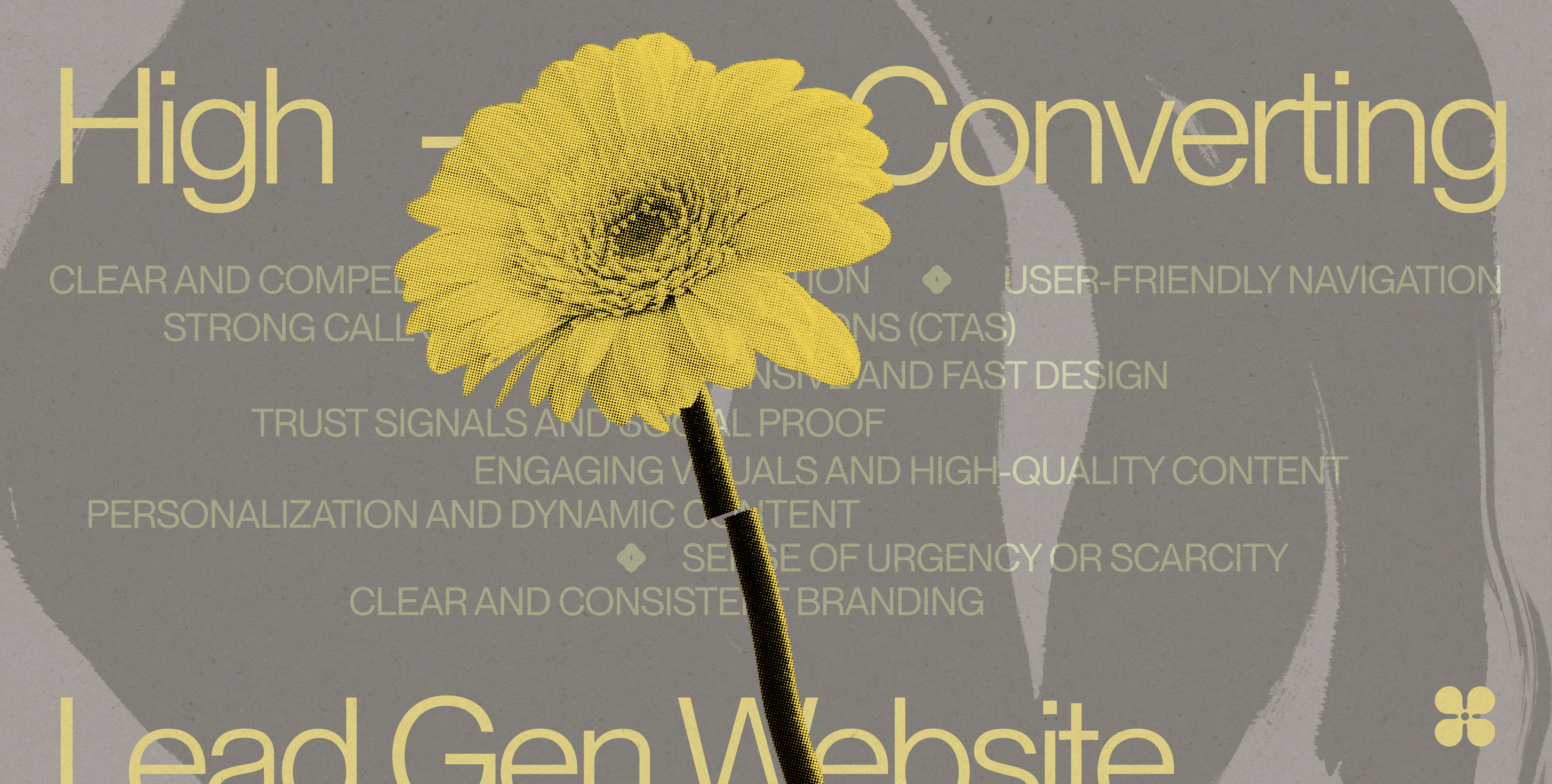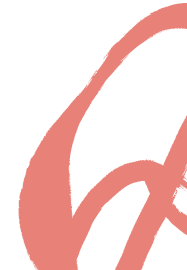Outline:
Websites are more than online brochures today—they can help you attract new customers and boost your business. A well-crafted lead generation website design can pull in prospects, warm them up, and then turn them into real opportunities for your business.
Recent stats show that businesses investing in strong lead generation strategies see up to 50% more leads each month compared to those that neglect this key element. This guide will walk you through what a lead generation website is, how to nail your lead generation website design, best practices, and even highlight some of the best lead gen website examples out there. Let’s dive in and see how you can set up a website that truly works for you.
The Importance of a Lead Generation Website Design
A modern business website isn’t just about listing your services or displaying a neat portfolio. Today, the focus is on converting visitors into leads—people who are interested in what you offer. In other words, your website should be a lead generation tool that pulls in your target audience, nudges them along, and then helps you capture their details for further follow-up.
A great lead generation website design does more than just inform; it engages. It welcomes visitors with clear messaging, directs them toward key actions, and uses persuasive elements like calls-to-action, trust badges, and compelling visuals. Whether you’re in retail, tech, consulting, or any other b2b industry, a website that’s geared toward generating leads can give you a competitive edge.
Why Focus on Lead Generation
Lead generation is all about filling your sales funnel with people who may become paying customers. It’s the first step in nurturing relationships and growing your customer base. When your website is built with lead generation in mind, you’re not just building a pretty online presence—you’re setting up a system that works around the clock to bring new business your way.
This importance is backed by real data. Companies that focus on lead generation and use smart website design strategies report higher conversion rates, increased customer engagement, and ultimately, greater revenue. With the right approach, your website becomes a dynamic part of your overall sales and marketing process.
What Is a Lead Generation Website
Simply put, a lead generation website is a platform that is purposely designed to capture visitor information and turn them into potential customers. Unlike traditional websites that merely share information about your business, a lead generation website actively seeks to engage visitors and guide them toward a specific goal. Let’s explore further.
Key Features Of a Lead Generation Website Design
Here are a few features that every lead generation website examples should have:
- Clear and Compelling CTAs: Call-to-actions are the stepping stones that lead your visitors to take the next step. Whether it’s a button that says “Get Started” or “Learn More,” CTAs need to stand out and be simple to follow.
- Easy-to-use Forms: When it comes to collecting contact details, forms should be straightforward. Don’t ask for too much at once—keep things light so people don’t bail out halfway.
- Responsive and Fast-loading Pages: Visitors can easily bounce if your site is slow or doesn’t display well on mobile devices. Make sure your design works well across different screens.
- Trust-building Elements: Testimonials, case studies, and trust badges go a long way in building credibility. These elements help ease any hesitation potential leads might have.
- Content That Speaks: Whether through blog posts, videos, or downloadable guides, your content should clearly communicate the benefits of your offerings and answer any questions your visitors might have.
Crafting an Effective Lead Generation Website Design
Creating a web design lead generation website that truly converts visitors into leads involves a mix of art and strategy. Here are some tactics to help you create a stellar design:
01 Keep It Simple and Clear
Remember, your website’s job is to make it easy for visitors to take one clear step after another. Start by organizing your content into digestible sections. Make your message plain and to the point—don’t overcomplicate things. Break down your information into headlines, short paragraphs, and bullet points so it’s easy to scan.
- Break down complex topics into simple parts.
- Step up your game with a clean layout.
- Follow through on your promise with consistent messaging.
02 Focus on User Experience
When you set out to build a lead generation website, think about the journey your visitors will take. Make sure navigation is intuitive so that users can easily find what they’re looking for. Use visuals and icons to point people in the right direction, and keep your pathways short and sweet. The fewer obstacles, the better your conversion rate will be.
03 Optimize for Mobile and Speed
A site that loads slowly or doesn’t work well on mobile devices can turn leads away faster than you can say “bounce rate.” Work on ensuring that your website loads quickly and is fully responsive. Optimize images, streamline code, and avoid any flashy elements that might slow things down. A mobile-friendly design is no longer optional—it’s a necessity.
04 Use Persuasive Design Elements
Elements like colors, fonts, and imagery play a big role in how visitors perceive your website. Choose a color palette that speaks to your brand and highlights your CTAs. Use fonts that are easy to read and pair them with high-quality visuals that complement your message. It’s all about setting the right tone and mood, making sure that your visitor’s attention is grabbed from the get-go.
05 Test and Tweak
The beauty of a digital space is that it’s never set in stone. Once your website is up and running, keep an eye on how visitors are interacting with it. Use A/B testing to compare different headlines, CTAs, and layouts. Look at your conversion rates and bounce rates, and be ready to make changes on the fly. Keep testing, learning, and optimizing until you find the winning formula.
Best Practices for Lead Generation Website Design
Even if you have a great design for your lead generation site, there are some best practices that you can apply to take it to the next level. Keeping the following points in mind will help you stay on top of your game:
Craft Engaging Headlines and Subheadings
Your headlines should draw people in. They need to be clear, compelling, and directly speak to your audience’s needs or pain points. A good headline can do a lot of the heavy lifting, so make sure yours hit the mark.
Create a Seamless User Experience
Every part of your website should guide a visitor smoothly toward taking action. This means having logical navigation, consistent b2b branding, and a clear path from one piece of content to the next. When things are easy to follow, visitors are more likely to stick around and convert.
Keep Forms Short and Sweet
When you’re asking visitors to share their information, less is more. Reduce the number of fields in your forms so that they’re not too intimidating to adhere to customer-centric web design. Ask only for what you really need at that moment. This small tweak can significantly improve your form completion rates.
Build Trust with Social Proof
Featuring customer testimonials, case studies, or logos of well-known clients can help reassure visitors that they’re in safe hands. Social proof is a powerful tool, as it shows potential leads that others have benefited from your service or product.
Leverage Visuals and Multimedia
Pictures, videos, and infographics can explain complex ideas quickly and engagingly. Don’t be afraid to include multimedia elements where they make sense. They can break up text and keep your visitors’ attention locked in.
Pay Attention to SEO
Even the best lead gen website examples will struggle if it’s not visible to your target audience. Make sure your content is optimized for search engines. Use relevant keywords naturally, and update your content regularly so that search engines—and visitors—see that you’re active and relevant.
Use Clear Calls-to-Action
Each page on your site should have a clear and inviting call-to-action. Whether it’s to sign up for a newsletter, download a free resource, or request a demo, CTAs should be prominent and persuasive. Experiment with the placement and wording of these buttons or links to see what drives the best results.
Lead Gen Website Examples: Real-World Inspiration
One of the best ways to learn is by looking at what others are doing right. Here are some of the leading lead gen website examples and what makes them tick:
UIcons
UIcons is a great example of a lead gen site. They make it super easy to find and grab the icons you need with clear calls to action like “Get Started.” The site looks good and works fast on any device, plus their branding is spot-on. While it’s not overtly personalized, the way they’ve organized everything makes it easy to find exactly what you’re looking for, which is a kind of personalization in itself.
HubSpot
HubSpot stands as a prime example of effective lead generation website design. Their website is loaded with value-packed content such as eBooks, webinars, and industry insights that are freely available to visitors. This generous content strategy pulls users in and offers them a taste of what HubSpot can do.
- Clear CTAs: Every page pushes users to sign up for a demo or download a piece of valuable content.
- Well-optimized forms: HubSpot’s forms are short and to the point, reducing friction and increasing conversion rates.
- Trust and Social Proof: Numerous testimonials and case studies help build confidence in their solutions.

Zelh
Zelh’s outstaffing page nails lead generation. They’ve got a clear value proposition (find top tech talent), strong CTAs (like “Contact Us”), and engaging visuals. The content is high-quality and explains their services well. They also build trust with client logos and testimonials, reinforcing their branding throughout. It’s a solid example of how to attract leads for staffing services.
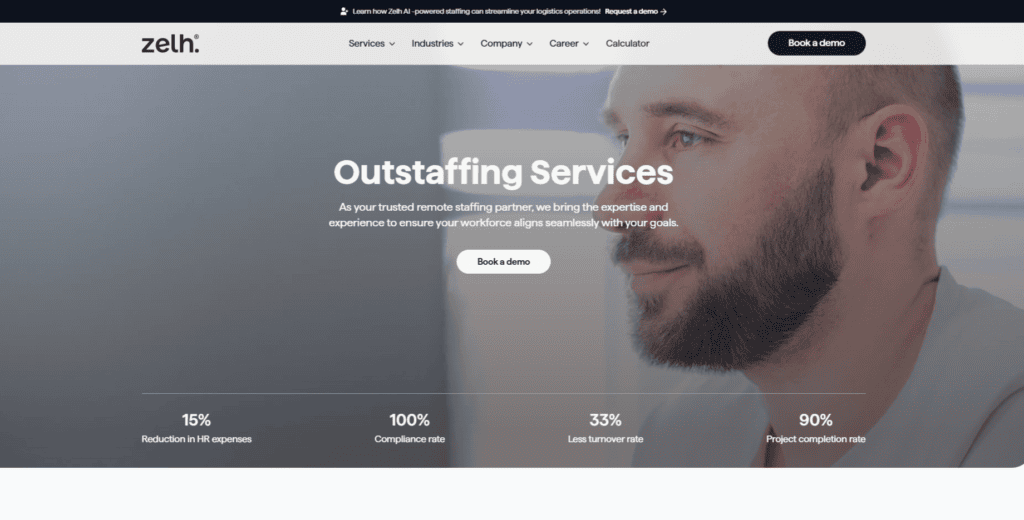
Salesforce
Salesforce’s website is another shining example of a web design lead generation website that knows how to guide visitors along their buyer’s journey. Their landing pages are designed to be both informative and persuasive.
- Engaging visuals and narratives: The use of clear, persuasive language backed up with data and success stories helps convert visitors.
- Interactive pathways: Features like interactive demos and guided product tours keep visitors involved and provide them with a personalized experience.
- Strong CTAs: Salesforce makes it easy for visitors to sign up for a trial or request additional information, which increases their conversion rate.

XCold
XCold Chain’s site is a good example of lead gen for specialized logistics. They’ve got clear CTAs (like “Get a Quote”) and emphasize their expertise in temperature-controlled transport. While not heavily personalized, the site is responsive and loads quickly. It focuses on building trust in their cold chain solutions, although a stronger sense of urgency or scarcity could further boost lead generation.

Mailchimp
Mailchimp has managed to create a clean, approachable website that encourages people to get started with their email marketing services. Their focus is on simplicity and speed.
- Simplicity in design: An uncluttered interface helps visitors navigate without feeling overwhelmed.
- Clear value proposition: By clearly stating the benefits of their service, Mailchimp quickly catches the interest of potential leads.
- Minimal distraction: With clear, focused CTAs and a straightforward layout, users are naturally led through the conversion process.
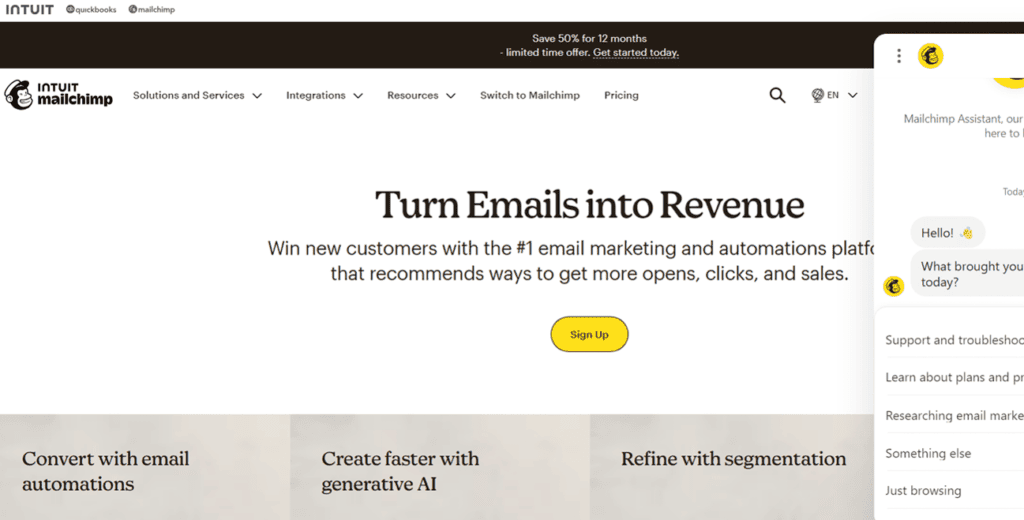
Zendesk
Zendesk’s approach to web design lead generation is focused on building trust. Their website makes great use of customer testimonials and case studies to highlight the success stories of their clients.
- User-friendly navigation: Zendesk’s site is designed with the user in mind, making it simple for visitors to find answers and take action.
- Effective CTAs: Whether it’s a demo sign-up or a free trial request, Zendesk makes it clear what steps visitors need to take.
- Visual appeal and clarity: The combination of strong visual elements with concise messaging is key to their website’s success.
These lead generation website examples prove that a well-thought-out design coupled with smart strategies can set your site apart from the competition.
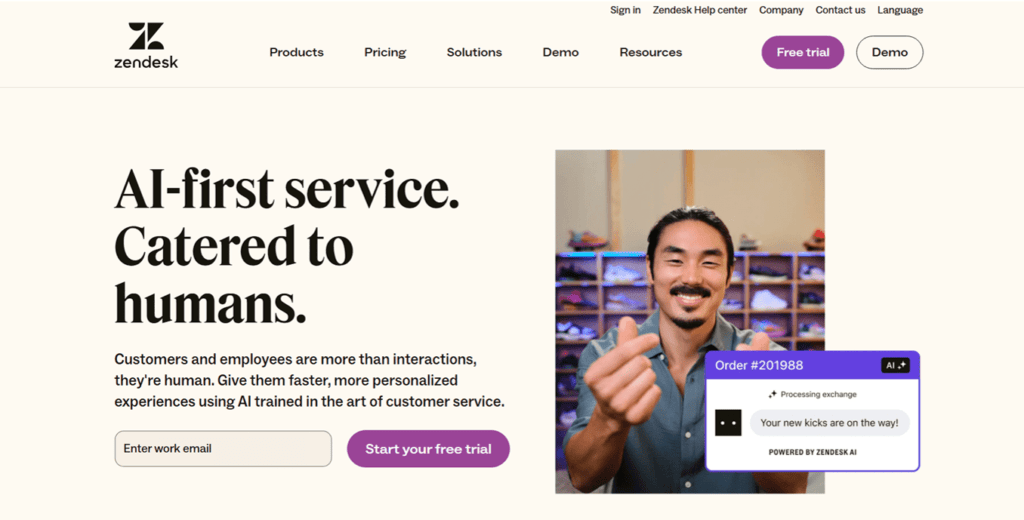
Bringing It All Together: Your Lead Generation Powerhouse Tips
Now that we’ve looked at what makes a great lead generation website and how to nail the design, it’s time to wrap things up with some final thoughts.
Focus on the Journey
Creating an effective lead generation website design is all about focusing on the customer journey. Think of your website as a path that gently leads your visitors step by step—from initial interest to final conversion. Each part of your site should work together seamlessly to guide users along this path.
Keep Testing and Tweaking
The digital landscape is always shifting, and what works today might need a tweak tomorrow. Keep testing different elements of your site—from headlines and images to CTAs and forms. Use analytics to see what’s working and what isn’t, and be willing to change things up when needed. It’s all about staying ahead of the curve and continuously improving your approach.
Learn from the Best
Take inspiration from the lead gen website examples we discussed earlier. Analyze what they’re doing right and think about how you can apply those lessons to your own site. Whether it’s simplifying your forms or improving your CTAs, look for small changes that can lead to big results.
Always Keep Your Audience in Mind
At the heart of every successful website is a deep understanding of its audience. Know who you’re talking to, what their needs are, and how you can help them. Write in a way that resonates with your visitors. Use simple language, keep your tone approachable, and throw in some phrasal verbs to keep things lively—this isn’t just content; it’s a conversation.
Bringing Your Ideas to Life
In conclusion, the journey of creating a successful lead generation website is as much about design as it is about strategy. It’s about rolling up your sleeves, testing different ideas, and continuously refining your approach. With careful planning and the right tools, you can set up a website that not only looks good but also serves as a strong lead generation engine for your business.
On a Final Note
Building a lead generation website is an ongoing process. It requires you to break down your strategy into manageable parts, step up your website’s performance, and continuously follow through on improvements.
By keeping your design simple, your messaging clear, and your audience’s journey at the center of your strategy, you’re setting yourself up for success. So, dive in, start building or revamping your site, and watch how a well-tuned lead generation machine can transform your business. Start experimenting with your design, watch the analytics roll in, and celebrate the small victories along the way.
Your next big lead generation website design could be just one click away! Feel free to get in touch with us for a prosperous partnership, we would be glad to assist you in achieving your goals.

